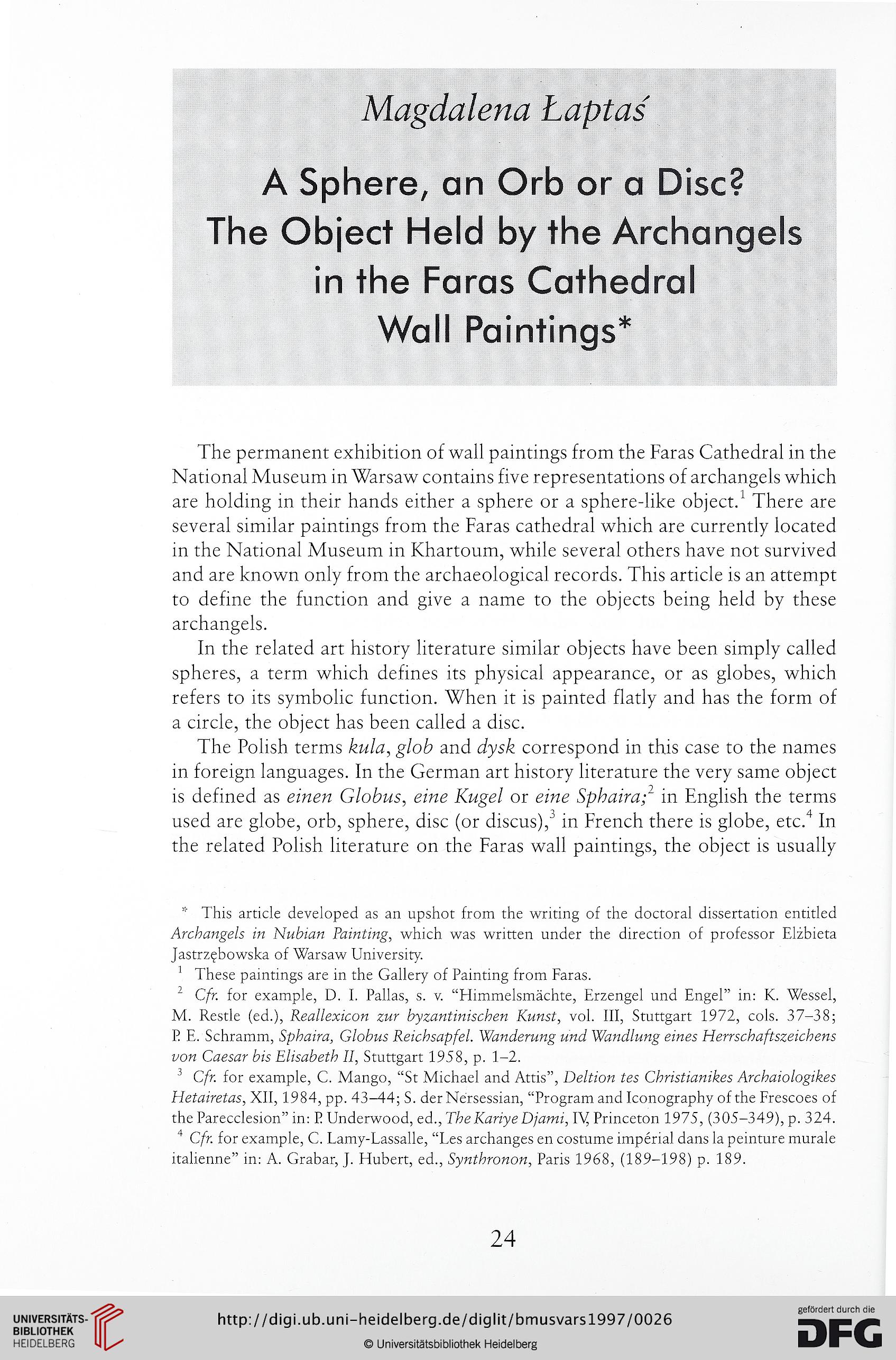Magdalena Laptas
A Sphere, an Orb or a Disc?
The Object Held by the Archangels
in the Faras Cathedral
Wall Paintings*
The permanent exhibition of wall paintings from the Faras Cathedral in the
National Museum in Warsaw contains five representations of archangels which
are holding in their hands either a sphere or a sphere-like object. There are
several similar paintings from the Faras cathedral which are currently located
in the National Museum in Khartoum, while several others have not survived
and are known only from the archaeological records. This article is an attempt
to define the function and give a name to the objects being held by these
archangels.
In the related art history literature similar objects have been simply called
spheres, a term which defines its physical appearance, or as globes, which
refers to its symbolic function. When it is painted flatly and has the form of
a circle, the object has been called a disc.
The Polish terms kula, glob and dysk correspond in this case to the names
in foreign languages. In the German art history literature the very same object
is defined as einen Globus, eine Kugel or eine Sphaira;2 in English the terms
used are globe, orb, sphere, disc (or discus),3 in French there is globe, etc.4 In
the related Polish literature on the Faras wall paintings, the object is usually
* This article developed as an upshot from the writing of the doctoral dissertation entitled
Archangels in Nubian Painting, which was written under the direction of professor Elzbieta
Jastrzçbowska of Warsaw University.
1 These paintings are in the Gallery of Painting from Faras.
2 Cfr. for example, D. I. Pallas, s. v. “Himmelsmächte, Erzengel und Engel” in: K. Wessel,
M. Restle (ed.), Reallexicon zur byzantinischen Kunst, vol. Ill, Stuttgart 1972, cols. 37-38;
P E. Schramm, Sphaira, Globus Reichsapfel. Wanderung und Wandlung eines Herrschaftszeichens
von Caesar bis Elisabeth II, Stuttgart 1958, p. 1-2.
3 Cfr. for example, C. Mango, “St Michael and Attis”, Deltion tes Christianikes Archaiologikes
Hetairetas, XII, 1984, pp. 43-44; S. der Nersessian, “Program and Iconography of the Frescoes of
the Parecclesion” in: P Underwood, ed., TheKariyeDjami, IY Princeton 1975, (305-349), p. 324.
4 Cfr. for example, C. Lamy-Lassalle, “Les archanges en costume impérial dans la peinture murale
italienne” in: A. Grabar, J. Hubert, ed., Synthronon, Paris 1968, (189-198) p. 189.
24
A Sphere, an Orb or a Disc?
The Object Held by the Archangels
in the Faras Cathedral
Wall Paintings*
The permanent exhibition of wall paintings from the Faras Cathedral in the
National Museum in Warsaw contains five representations of archangels which
are holding in their hands either a sphere or a sphere-like object. There are
several similar paintings from the Faras cathedral which are currently located
in the National Museum in Khartoum, while several others have not survived
and are known only from the archaeological records. This article is an attempt
to define the function and give a name to the objects being held by these
archangels.
In the related art history literature similar objects have been simply called
spheres, a term which defines its physical appearance, or as globes, which
refers to its symbolic function. When it is painted flatly and has the form of
a circle, the object has been called a disc.
The Polish terms kula, glob and dysk correspond in this case to the names
in foreign languages. In the German art history literature the very same object
is defined as einen Globus, eine Kugel or eine Sphaira;2 in English the terms
used are globe, orb, sphere, disc (or discus),3 in French there is globe, etc.4 In
the related Polish literature on the Faras wall paintings, the object is usually
* This article developed as an upshot from the writing of the doctoral dissertation entitled
Archangels in Nubian Painting, which was written under the direction of professor Elzbieta
Jastrzçbowska of Warsaw University.
1 These paintings are in the Gallery of Painting from Faras.
2 Cfr. for example, D. I. Pallas, s. v. “Himmelsmächte, Erzengel und Engel” in: K. Wessel,
M. Restle (ed.), Reallexicon zur byzantinischen Kunst, vol. Ill, Stuttgart 1972, cols. 37-38;
P E. Schramm, Sphaira, Globus Reichsapfel. Wanderung und Wandlung eines Herrschaftszeichens
von Caesar bis Elisabeth II, Stuttgart 1958, p. 1-2.
3 Cfr. for example, C. Mango, “St Michael and Attis”, Deltion tes Christianikes Archaiologikes
Hetairetas, XII, 1984, pp. 43-44; S. der Nersessian, “Program and Iconography of the Frescoes of
the Parecclesion” in: P Underwood, ed., TheKariyeDjami, IY Princeton 1975, (305-349), p. 324.
4 Cfr. for example, C. Lamy-Lassalle, “Les archanges en costume impérial dans la peinture murale
italienne” in: A. Grabar, J. Hubert, ed., Synthronon, Paris 1968, (189-198) p. 189.
24




